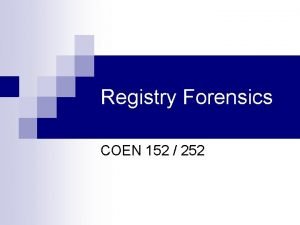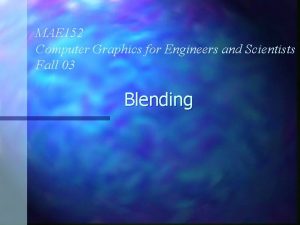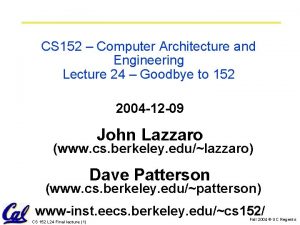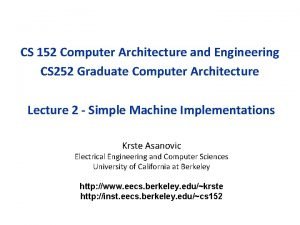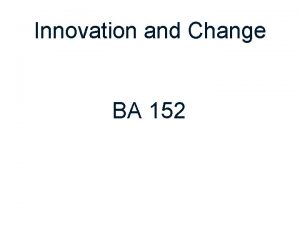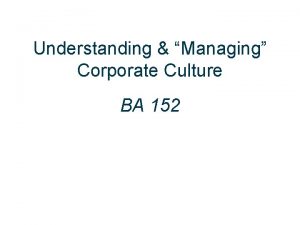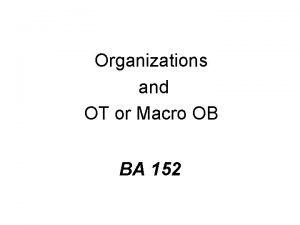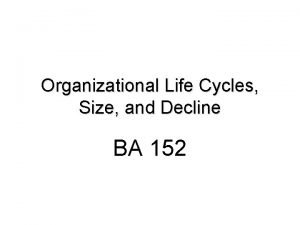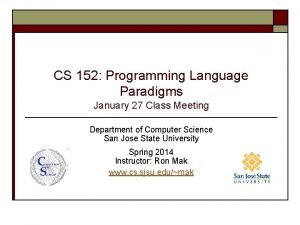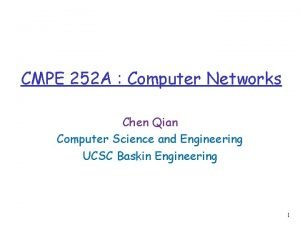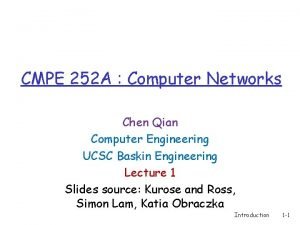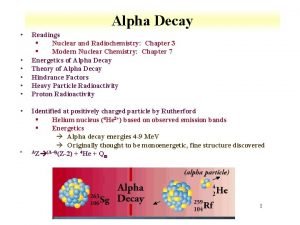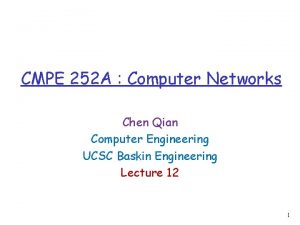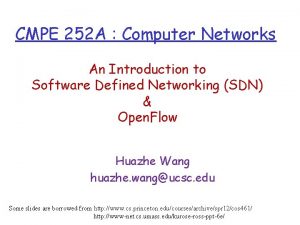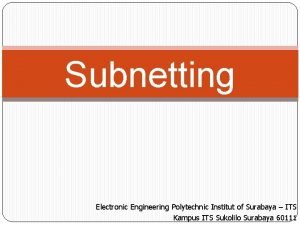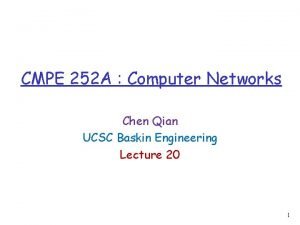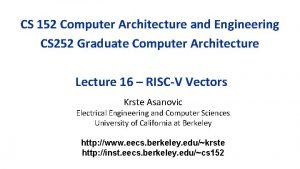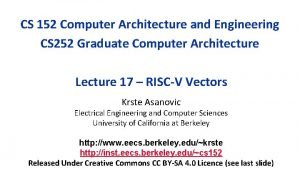CS 152 Computer Architecture and Engineering CS 252







![One-Transistor Dynamic RAM [Dennard, IBM] 1 -T DRAM Cell word access transistor Ti. N One-Transistor Dynamic RAM [Dennard, IBM] 1 -T DRAM Cell word access transistor Ti. N](https://slidetodoc.com/presentation_image_h/298bdcbda90243f415812ab5e373966c/image-8.jpg)
![Modern DRAM Structure [Samsung, sub-70 nm DRAM, 2004] 9 Modern DRAM Structure [Samsung, sub-70 nm DRAM, 2004] 9](https://slidetodoc.com/presentation_image_h/298bdcbda90243f415812ab5e373966c/image-9.jpg)


![DRAM Packaging, Mobile Devices [ Apple A 4 package on circuit board] Two stacked DRAM Packaging, Mobile Devices [ Apple A 4 package on circuit board] Two stacked](https://slidetodoc.com/presentation_image_h/298bdcbda90243f415812ab5e373966c/image-12.jpg)


























- Slides: 38

CS 152 Computer Architecture and Engineering CS 252 Graduate Computer Architecture Lecture 5 – Memory Krste Asanovic Electrical Engineering and Computer Sciences University of California at Berkeley http: //www. eecs. berkeley. edu/~krste http: //inst. eecs. berkeley. edu/~cs 152

Last time in Lecture 4 § Handling exceptions in pipelined machines by passing exceptions down pipeline until instructions cross commit point in order § Can use values before commit through bypass network § Pipeline hazards can be avoided through software techniques: scheduling, loop unrolling § Decoupled architectures use queues between “access” and “execute” pipelines to tolerate long memory latency § Regularizing all functional units to have same latency simplifies more complex pipeline design by avoiding structural hazards, can be expanded to in-order superscalar designs 2

Early Read-Only Memory Technologies Punched cards, From early 1700 s through Jaquard Loom, Babbage, and then IBM Punched paper tape, instruction stream in Harvard Mk 1 Diode Matrix, EDSAC-2 µcode store IBM Card Capacitor ROS IBM Balanced Capacitor ROS 3

Early Read/Write Main Memory Technologies Babbage, 1800 s: Digits stored on mechanical wheels Williams Tube, Manchester Mark 1, 1947 Mercury Delay Line, Univac 1, 1951 Also, regenerative capacitor memory on Atanasoff-Berry computer, and rotating magnetic drum memory on IBM 650 4

MIT Whirlwind Core Memory 5

Core Memory § Core memory was first large scale reliable main memory – invented by Forrester in late 40 s/early 50 s at MIT for Whirlwind project § § § Bits stored as magnetization polarity on small ferrite cores threaded onto two-dimensional grid of wires § Coincident current pulses on X and Y wires would write cell and also sense original state (destructive reads) Robust, non-volatile storage Used on space shuttle computers Cores threaded onto wires by hand (25 billion a year at peak production) Core access time ~ 1µs DEC PDP-8/E Board, 4 K words x 12 bits, (1968) 6

Semiconductor Memory § Semiconductor memory began to be competitive in early 1970 s – Intel formed to exploit market for semiconductor memory – Early semiconductor memory was Static RAM (SRAM). SRAM cell internals similar to a latch (cross-coupled inverters). § First commercial Dynamic RAM (DRAM) was Intel 1103 – 1 Kbit of storage on single chip – charge on a capacitor used to hold value Semiconductor memory quickly replaced core in ‘ 70 s 7
![OneTransistor Dynamic RAM Dennard IBM 1 T DRAM Cell word access transistor Ti N One-Transistor Dynamic RAM [Dennard, IBM] 1 -T DRAM Cell word access transistor Ti. N](https://slidetodoc.com/presentation_image_h/298bdcbda90243f415812ab5e373966c/image-8.jpg)
One-Transistor Dynamic RAM [Dennard, IBM] 1 -T DRAM Cell word access transistor Ti. N top electrode (VREF) Ta 2 O 5 dielectric VREF bit Storage capacitor (FET gate, trench, stack) poly word line W bottom electrode access transistor 8
![Modern DRAM Structure Samsung sub70 nm DRAM 2004 9 Modern DRAM Structure [Samsung, sub-70 nm DRAM, 2004] 9](https://slidetodoc.com/presentation_image_h/298bdcbda90243f415812ab5e373966c/image-9.jpg)
Modern DRAM Structure [Samsung, sub-70 nm DRAM, 2004] 9

DRAM Architecture Col. 1 Col. 2 M M word lines Row 1 Row Address Decoder N N+M bit lines Row 2 N Column Decoder & Sense Amplifiers Data Memory cell (one bit) D § Bits stored in 2 -dimensional arrays on chip § Modern chips have around 4 -8 logical banks on each chip § each logical bank physically implemented as many smaller arrays 10

DRAM Packaging (Laptops/Desktops/Servers) Clock and control signals ~7 Address lines multiplexed row/column address ~12 DRAM chip Data bus (4 b, 8 b, 16 b, 32 b) § DIMM (Dual Inline Memory Module) contains multiple chips with clock/control/address signals connected in parallel (sometimes need buffers to drive signals to all chips) § Data pins work together to return wide word (e. g. , 64 -bit data bus using 16 x 4 -bit parts) 11
![DRAM Packaging Mobile Devices Apple A 4 package on circuit board Two stacked DRAM Packaging, Mobile Devices [ Apple A 4 package on circuit board] Two stacked](https://slidetodoc.com/presentation_image_h/298bdcbda90243f415812ab5e373966c/image-12.jpg)
DRAM Packaging, Mobile Devices [ Apple A 4 package on circuit board] Two stacked DRAM die Processor plus logic die [ Apple A 4 package cross-section, i. Fixit 2010 ] 12

DRAM Packaging Apple A 10 13

DRAM Operation § Three steps in read/write access to a given bank § Row access (RAS) – – decode row address, enable addressed row (often multiple Kb in row) bitlines share charge with storage cell small change in voltage detected by sense amplifiers which latch whole row of bits sense amplifiers drive bitlines full rail to recharge storage cells § Column access (CAS) – decode column address to select small number of sense amplifier latches (4, 8, 16, or 32 bits depending on DRAM package) – on read, send latched bits out to chip pins – on write, change sense amplifier latches which then charge storage cells to required value – can perform multiple column accesses on same row without another row access (burst mode) § Precharge – charges bit lines to known value, required before next row access § Each step has a latency of around 15 -20 ns in modern DRAMs § Various DRAM standards (DDR, RDRAM) have different ways of encoding the signals for transmission to the DRAM, but all share same core architecture 14

200 MHz Clock Double-Data Rate (DDR 2) DRAM Row Column Precharge Row’ Data [ Micron, 256 Mb DDR 2 SDRAM datasheet ] 400 Mb/s Data Rate 15

CPU-Memory Bottleneck CPU Memory Performance of high-speed computers is usually limited by memory bandwidth & latency § Latency (time for a single access) – Memory access time >> Processor cycle time § Bandwidth (number of accesses per unit time) if fraction m of instructions access memory � 1+m memory references / instruction �CPI = 1 requires 1+m memory refs / cycle (assuming RISC-V ISA) 16

Processor-DRAM Gap (latency) µProc 60%/year Performance 1000 CPU 100 Processor-Memory Performance Gap: (growing 50%/yr) 10 DRAM 7%/year 1982 1983 1984 1985 1986 1987 1988 1989 1990 1991 1992 1993 1994 1995 1996 1997 1998 1999 2000 1 1980 1981 DRAM Time Four-issue 3 GHz superscalar accessing 100 ns DRAM could execute 1, 200 instructions during time for one memory access! 17

Physical Size Affects Latency CPU Small Memory Big Memory § Signals have further to travel § Fan out to more locations 18

Relative Memory Cell Sizes On-Chip SRAM in logic chip DRAM on memory chip [ Foss, “Implementing Application-Specific Memory”, ISSCC 1996 ] 19

Memory Hierarchy A CPU Small, Fast Memory (RF, SRAM) B Big, Slow Memory (DRAM) holds frequently used data • capacity: Register << SRAM << DRAM • latency: Register << SRAM << DRAM • bandwidth: on-chip >> off-chip On a data access: if data Î fast memory low latency access (SRAM) if data Ï fast memory high latency access (DRAM) 20

CS 152 Administrivia 21

CS 252 Administrivia CS 252 22

Management of Memory Hierarchy § Small/fast storage, e. g. , registers – Address usually specified in instruction – Generally implemented directly as a register file • but hardware might do things behind software’s back, e. g. , stack management, register renaming § Larger/slower storage, e. g. , main memory – Address usually computed from values in register – Generally implemented as a hardware-managed cache hierarchy (hardware decides what is kept in fast memory) • but software may provide “hints”, e. g. , don’t cache or prefetch 23

Memory Address (one dot per access) Real Memory Reference Patterns Donald J. Hatfield, Jeanette Gerald: Program Restructuring for Virtual Memory. IBM Systems Journal 10(3): 168 -192 (1971) Time 24

Typical Memory Reference Patterns Address n loop iterations Instruction fetches Stack accesses subroutine call subroutine return argument access s Data accesses r to c e v es c c a scalar accesses Time 25

Two predictable properties of memory references: § Temporal Locality: If a location is referenced it is likely to be referenced again in the near future. § Spatial Locality: If a location is referenced it is likely that locations near it will be referenced in the near future. 26

Memory Address (one dot per access) Memory Reference Patterns Temporal Locality Spatial Locality Donald J. Hatfield, Jeanette Gerald: Program Time Restructuring for Virtual Memory. IBM Systems 27 Journal 10(3): 168 -192 (1971)

Caches exploit both types of predictability: § Exploit temporal locality by remembering the contents of recently accessed locations. § Exploit spatial locality by fetching blocks of data around recently accessed locations. 28

Inside a Cache Address Processor Address CACHE Data copy of main memory location 100 Address Tag Main Memory copy of main memory location 101 100 Data Byte 304 Data Byte Line 6848 416 Data Block 29

Cache Algorithm (Read) Look at Processor Address, search cache tags to find match. Then either Found in cache a. k. a. HIT Return copy of data from cache Not in cache a. k. a. MISS Read block of data from Main Memory Wait … Return data to processor and update cache Q: Which line do we replace? 30

Placement Policy Block Number 11111 22222 33 0123456789 01 Memory Set Number 0 1 2 3 01234567 Cache block 12 can be placed Fully Associative anywhere (2 -way) Set Associative anywhere in set 0 (12 mod 4) Direct Mapped only into block 4 (12 mod 8) 31

Direct-Mapped Cache Tag Index t V k Tag Block Offset Data Block b 2 k lines t = HIT Data Word or Byte 32

Direct Map Address Selection higher-order vs. lower-order address bits Tag Index k Block Offset t V Tag Data Block b 2 k lines t = HIT Data Word or Byte 33

2 -Way Set-Associative Cache Tag Index t k Data Block V Tag Block Offset V Tag b Data Block t = = Data Word or Byte HIT 34

Fully Associative Cache V Tag Data Block t Tag = t = Block Offset HIT b = Data Word or Byte 35

Replacement Policy In an associative cache, which block from a set should be evicted when the set becomes full? • Random • Least-Recently Used (LRU) • LRU cache state must be updated on every access • true implementation only feasible for small sets (2 -way) • pseudo-LRU binary tree often used for 4 -8 way • First-In, First-Out (FIFO) a. k. a. Round-Robin • used in highly associative caches • Not-Most-Recently Used (NMRU) • FIFO with exception for most-recently used block or blocks This is a second-order effect. Why? Replacement only happens on misses 36

Block Size and Spatial Locality Block is unit of transfer between the cache and memory Tag Split CPU address Word 0 Word 1 Word 2 Word 3 block address 4 word block, b=2 offsetb b bits 32 -b bits 2 b = block size a. k. a line size (in bytes) Larger block size has distinct hardware advantages • less tag overhead • exploit fast burst transfers from DRAM • exploit fast burst transfers over wide busses What are the disadvantages of increasing block size? Fewer blocks => more conflicts. Can waste bandwidth. 37

Acknowledgements § This course is partly inspired by previous MIT 6. 823 and Berkeley CS 252 computer architecture courses created by my collaborators and colleagues: – – – Arvind (MIT) Joel Emer (Intel/MIT) James Hoe (CMU) John Kubiatowicz (UCB) David Patterson (UCB) 38
 Difference between architecture and organization
Difference between architecture and organization Bus architecture in computer organization
Bus architecture in computer organization What is system in software engineering
What is system in software engineering Basic computer organisation and design
Basic computer organisation and design Unr152
Unr152 Forensics
Forensics Przedszkole 152 łódź
Przedszkole 152 łódź Law society of tasmania v richardson
Law society of tasmania v richardson Nearest ten thousand
Nearest ten thousand Mae 152
Mae 152 Graphics for engineers
Graphics for engineers Cs 152 stanford
Cs 152 stanford Cs 152 berkeley
Cs 152 berkeley Ba 152
Ba 152 Ece 152
Ece 152 Ba 152
Ba 152 Lorne priemaza
Lorne priemaza What ports are defined above 49 152
What ports are defined above 49 152 Ba 152
Ba 152 Macroob
Macroob Organizational atrophy
Organizational atrophy Plasa
Plasa Econ 152
Econ 152 Ron mak sjsu
Ron mak sjsu Gfi 152
Gfi 152 Acordada 252/02
Acordada 252/02 Cmpe 252
Cmpe 252 Chen qian ucsc
Chen qian ucsc Cf-252 decay scheme
Cf-252 decay scheme Simplifying radicals calculator
Simplifying radicals calculator History observation palpation special tests
History observation palpation special tests Cmpe 252
Cmpe 252 Cmpe 252
Cmpe 252 Binary to hexadecimal practice
Binary to hexadecimal practice 252 nömrəli məktəbin müəllimləri
252 nömrəli məktəbin müəllimləri 252 netmask
252 netmask 252 netmask
252 netmask 252 basics
252 basics Chen qian ucsc
Chen qian ucsc





